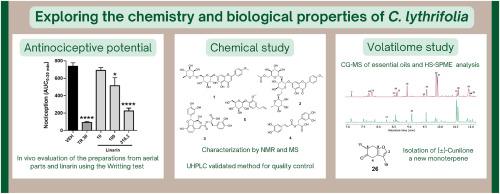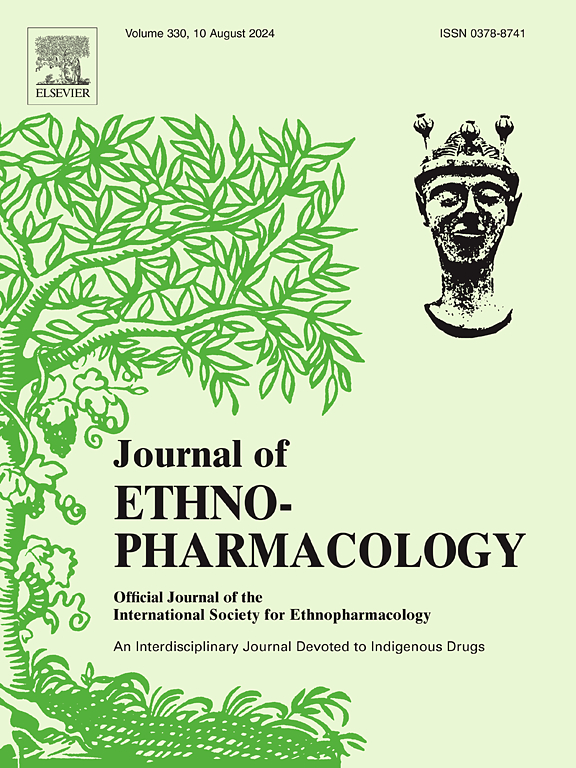植物化学分析和评估 Cunila lythrifolia Benth 气生部分对腹痛和一些消化酶的抑制作用
IF 4.8
2区 医学
Q1 CHEMISTRY, MEDICINAL
引用次数: 0
摘要
民族药理学的相关性Cunila lythrifolia Benth.(Lamiaceae) 俗称 "poleo de monte",是一种墨西哥植物,早在前西班牙时代就因其气生部分具有治疗呼吸道和胃肠道疾病、产后护理和壮阳的特性而闻名。材料和方法采用 Lorke 法对小鼠煎剂的临床前安全性进行了评估。使用醋酸诱导的小鼠蠕动试验评估了其抗痛作用,并通过联合使用纳洛酮探讨了其作用机制。此外,还使用比色法对脂肪酶和α-淀粉酶的抑制作用进行了测定,以计算抑制百分比。利用色谱技术分离了特殊代谢物,并通过质谱、核磁共振和气相分析确定了其特征。通过对精油进行气相色谱-质谱分析,以及通过 HSPM 与气相色谱-质谱联用,确定了气生部分的挥发性成分。根据 ICH 指南,对超高压液相色谱分析方法进行了验证,以定量分析 1.结果水提取物的半数致死剂量高于 5 克/千克。煎剂和精油的抗痛作用分别为 100 毫克/千克和 10 毫克/千克。精油对脂肪酶具有活性(抑制率为 96-76%)。从煎剂中分离出的化合物有:亚麻苷(1)、7-O-[2-O-乙酰基-β-D-吡喃葡萄糖基-(1 → 2)-[α-L-吡喃鼠李糖基-(1 → 6)]-β-D-吡喃葡萄糖苷](2)、石杉酸(3)、迷迭香酸(4)和柑橘素 C(5)。化合物 1 在 316 毫克/千克的剂量下显示出抗痛作用。对三个不同批次中 1 号化合物的超高效液相色谱定量方法进行了验证。挥发瘤分析表明,薄荷呋喃(10)、β-石竹烯(22)、石竹烯醇(31)和氧化石竹烯(32)是气生部分的主要成分。(从新鲜气生部分的精油中分离出一种新的薄荷呋喃衍生物 (±)-cunildone(27)。有助于该物种的化学鉴定和质量控制,并建立了该植物的定量分析方法。全面促进鱼腥草的合理使用和质量控制。本文章由计算机程序翻译,如有差异,请以英文原文为准。

Phytochemical analysis and evaluation of the inhibitory effect of the Cunila lythrifolia Benth aerial parts on abdominal pain and some digestive enzymes
Ethnopharmacology relevance
Cunila lythrifolia Benth. (Lamiaceae) commonly named “poleo de monte” is a Mexican plant known since pre-Hispanic times because of the properties of its aerial parts to treat respiratory and gastrointestinal conditions, for postpartum care, and as an aphrodisiac.
Aim of the study
To obtain preclinical evidence of the pharmacological properties of C. lythrifolia on abdominal pain and some digestive enzymes, as well as its chemical composition.
Material and methods
The preclinical safety of a decoction was evaluated by the Lorke method in mice. The antinociceptive effect was assessed using the acetic acid-induced writhing test in mice, and the mechanism of action was explored by the co-administration of naloxone. Additionally, the inhibition of the lipase and α-amylase was carried out using a colorimetric assay to calculate the percentage of inhibition. The isolation of specialized metabolites was carried out using chromatographic techniques, and characterization was established with MS, NMR, and chiroptical analysis. The volatile components of the aerial parts were identified by GC–MS analysis of the essential oils, and by HSPM coupled with GC−MS. An analytical method by UHPLC was validated under the guidelines of the ICH, for the quantification of 1.
Results
The LD50 of the aqueous extract is higher than 5 g/kg. The decoction and the essential oil have an antinociceptive effect at 100 and 10 mg/kg, respectively. The essential oil was active against the lipase enzyme (96−76 % of inhibition). The isolated compounds from the decoction were linarin (1), 7-O-[2-O-acetyl-β-D-glucopyranosyl-(1 → 2)-[α-L-rhamnopyranosyl-(1 → 6)]-β-D-glucopyranoside] (2), lithospermic acid (3), rosmarinic acid (4), and citrusin C (5). Compound 1 showed an antinociceptive effect at 316 mg/kg. A UHPLC method was validated for the quantification of 1 in three different batches. The volatiloma analysis revealed that menthofuran (10), β-caryophyllene (22), spathulenol (31), and caryophyllene oxide (32) are the major constituents in the aerial parts. (±)−cunildone (27) a new menthofuran derivative was isolated from the essential oil of the fresh aerial parts.
Conclusion
The results of these studies demonstrate the preclinical safety and validate the traditional use of C. lythrifolia as an antinociceptive agent. Contribute to the chemical identification of the species and to the quality control and establish a method for quantitative analysis of the plant. Overall promoting the rational use and quality control of C. lythrifolia.
求助全文
通过发布文献求助,成功后即可免费获取论文全文。
去求助
来源期刊

Journal of ethnopharmacology
医学-全科医学与补充医学
CiteScore
10.30
自引率
5.60%
发文量
967
审稿时长
77 days
期刊介绍:
The Journal of Ethnopharmacology is dedicated to the exchange of information and understandings about people''s use of plants, fungi, animals, microorganisms and minerals and their biological and pharmacological effects based on the principles established through international conventions. Early people confronted with illness and disease, discovered a wealth of useful therapeutic agents in the plant and animal kingdoms. The empirical knowledge of these medicinal substances and their toxic potential was passed on by oral tradition and sometimes recorded in herbals and other texts on materia medica. Many valuable drugs of today (e.g., atropine, ephedrine, tubocurarine, digoxin, reserpine) came into use through the study of indigenous remedies. Chemists continue to use plant-derived drugs (e.g., morphine, taxol, physostigmine, quinidine, emetine) as prototypes in their attempts to develop more effective and less toxic medicinals.
 求助内容:
求助内容: 应助结果提醒方式:
应助结果提醒方式:


